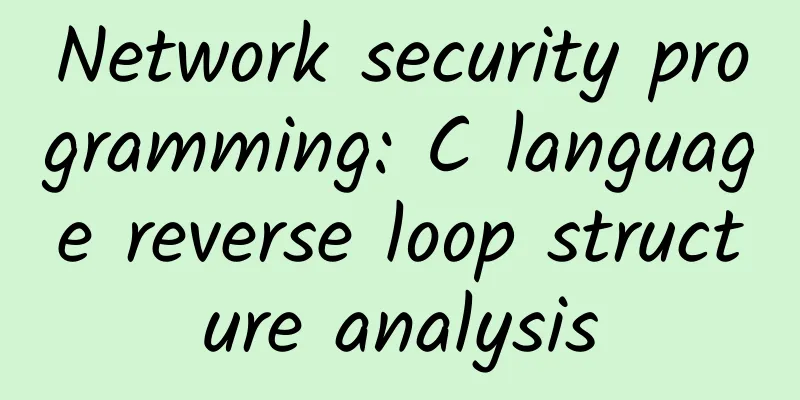Network security programming: C language reverse loop structure analysis

|
The loop structures of C language include for loop, while loop, do loop and goto loop. This article introduces the first three loop methods. 1. for loop structureThe for loop can also be called a step loop. Its characteristic is that it is often used to define the scope of the loop. Let's look at a simple C language code, as follows:
This is a typical program for finding the cumulative sum of 1 to 100. Through this program, we can understand the disassembly code of the for loop structure.
This time, the disassembled code has modified the variables and labels, which looks more intuitive. From the modified labels, the for structure can be divided into three parts: the part above LOC_STEP is the initialization part, the part below LOC_STEP is the part that modifies the loop variable, and the part below LOC_CMP and above LOC_ENDFOR is the part that compares the loop condition and the loop body. The disassembled structure of the for loop is as follows:
Let’s use IDA to look at the generated process structure diagram, as shown in Figure 1. Figure 1 Flowchart of the for structure 2. do…while loop structureThe body of the do loop is always executed once, which is the difference between the do loop and the while loop. Here is the code for adding 1 to 100. Let's take a look at its disassembly structure. First, let's look at the C language code, as follows:
The structure of the do loop is much simpler than that of the for loop, and the disassembled code is much less. Let's first look at the flowchart generated by IDA, as shown in Figure 2. Figure 2 do loop flow chart The disassembled code is as follows:
The body of the do loop is between LOC_DO and the jle of 0040104C. Its structure is as follows:
3. While loop structureThe difference between a while loop and a do loop is that a conditional check must be performed before entering the loop body. The loop body may not be executed once because the loop condition is not met.
Let's take a look at its disassembled code. The while loop has one more condition than the do loop, so there is one more branch. The disassembled code is as follows:
The main part of the while loop is between LOC_WHILE and LOC_WHILEEND. The two sentences below LOC_WHILE are cmp and jxx instructions, and the jmp instruction is above LOC_WHILEEND. These two parts are in a fixed format, and their structure is organized as follows:
Let’s take a look at the flowchart generated by IDA, as shown in Figure 3. Figure 3 while loop flow chart Among the three types of loops, for loop, do loop and while loop, the do loop is obviously more efficient, and the while loop is relatively more efficient than the for loop. |
>>: How wireless technology is changing the world
Recommend
Farewell to the NYSE! The NYSE maintains the delisting decision of the three major operators
[[398109]] On May 7, the three major operators is...
How many gateways in Flowable do you know?
Gateway Gateways are used to control the flow of ...
How to make the integrated wiring system more reasonable?
The integrated wiring system is a wiring system s...
spinservers: 10Gbps bandwidth US server $99/month - 2*E5-2630Lv3/128GB/1TB NVMe/30TB/month
spinservers has just released this month's pr...
EasyVM: $3/month KVM-2GB/30GB/2TB/Dallas & New York, etc.
EasyVM is a foreign hosting company founded in 20...
The next generation of computing defined by Cisco is born
For more than 30 years, Cisco has been driving th...
Sharktech: $99/month-2*E5-2670V2/32GB/500G SSD/1Gbps unlimited traffic/Los Angeles high defense
Sharktech cancelled the lowest-priced $59/month L...
More than 560,000 South Korean 5G users return to 4G: dissatisfied with 5G speed and poor signal coverage
Recently, more than 560,000 5G users in South Kor...
Virtual Private Server Operation Beginner's Guide
A Virtual Private Server (VPS) is a popular hosti...
HTTP connection management diagram
The HTTP protocol is very important to us program...
Hosteons: $2/month-1GB/15GB SSD/2TB@10Gbps bandwidth/Salt Lake City data center
A few days ago, I shared the promotion informatio...
DYXnet selected as a member of the SD-WAN+Informatization "Pilot" program to jointly promote high-quality development of the industry
On May 27, 2024 , the 2024 SD-WAN+Innovation &quo...
IDC: Global edge computing market will reach $250.6 billion in 2024
Industry data: Gartner conducted a survey and int...
Opportunity or chicken ribs? eMTC should not follow the NB-IoT price war
[[255921]] Recently, the official website of the ...
[11.11] UUUVPS special VPS annual payment starts from 128 yuan, Hong Kong/US 9929/4837/CN2 and other options
UUUVPS (SanYou Cloud) is a registered Hong Kong c...









